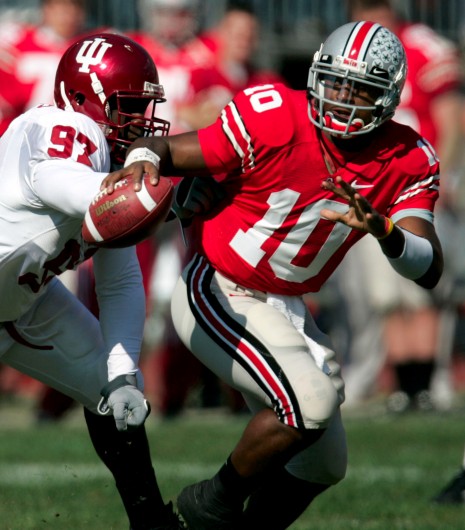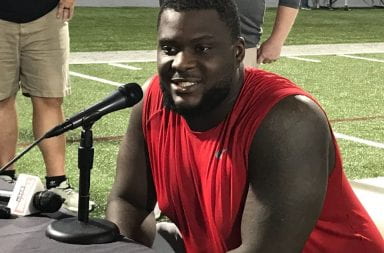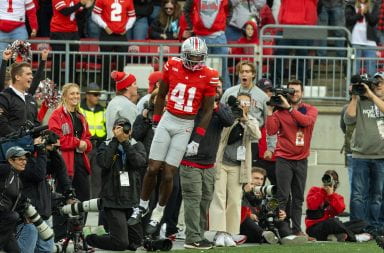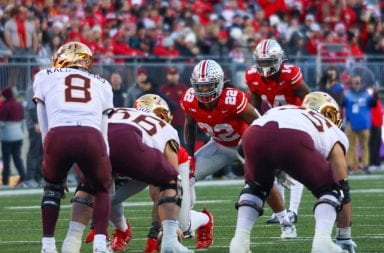
Ohio State quarterback Troy Smith (10) buys some time and eludes Indiana’s Keith Burrus (97) in the second quarter of a football game, Saturday, Oct. 21, 2006 at the Ohio Stadium in Columbus, Ohio. Ohio State won the contest, 44-3.
Credit: Courtesy of MCT
Ohio State has always been a perennial powerhouse when it comes to football, but the quarterback position historically has been one of vapidity and is infamous for being very uneventful until recent memory.
It was three yards in a cloud of dust, Woody Hayes style, and play dominant defense that was the formula for success until one Troy Smith stepped on campus. The quarterback was asked to control the clock, not make any crucial mistakes and by all means try to not lose the game instead of going out and winning it (see Craig Krenzel). Smith ushered in a new brand of football never before seen at Ohio State that would forever change the landscape of college football in the Big Ten.
Fast-forward to 2015, and you cannot watch a down without offenses being spread out with four- and five-receiver sets — but it wasn’t always this way. The Big Ten a mere eight years ago was embraced two tight end sets and a fullback leading the charge for a lead block on an iso run up the middle; that was the staple for the majority of offenses.
Even the national championship team of 2002 followed “Tressel ball” to a tee, letting Maurice Clarett carry the load on offense and relying on a dominant defense that would send five players to the NFL.
The changing of the guard came in 2004, when Tressel finally found a position for Smith at quarterback, where he was the backup to Justin Zwick. Previously as a redshirt freshman, Troy was seldom used, only earning playing time as a backup scat back and partially as a kick returner. Zwick was the more traditional one, standing 6’4’’ and operating from the pocket, while Smith was a dual threat who could easily beat defenses with either his arm or feet.
Once Smith took over full time, he didn’t disappoint with his dazzling and uncanny ability to make plays within and out of the pocket. Standing at only 6’0’’, Smith lacked both ideal height and arm strength for the quarterback position. However, what he lacked in physical gifts he made up for with his competitiveness and intangibles. Smith’s heart, grit and will to win are what propelled him into the player we all remember.
In big-time games when the pressure was on, no one in Buckeye history at the quarterback position was better than No. 10. Time and time again, he proved this with his play and performances in primetime action against worthy competition, including an incredible comeback against Michigan in 2005, another victory over the Wolverines the following year to secure a trip to the national championship game and a dominant performance against Notre Dame in the Fiesta Bowl..
Troy Smith’s impact and influence on modern Buckeye football is as apparent as can be. With the likes of Braxton Miller, Cardale Jones, J.T. Barrett and even Terrelle Pryor before them, all can point to one guy who paved the way and changed OSU football forever.
Smith’s dual-threat capabilities ushered in a new era that is more spread out and wide open than ever before. Even under the helm of ultra-conservative Jim Tressel, he knew what was best was to surround Troy with four or five receivers in the gun and let him do his thing — which was to torch defenses with both his arm and legs.
Fast-forward to 2015, and this is the same approach OSU coach Urban Meyer implements today, with a spread-out attack that allows multi-talented quarterbacks to flourish. The modern quarterbacks are all very different, with unique playing styles and even arguably more gifted and talented than Smith. However, none of them would be in the positions they are in without his grand influence.
The homebred Cleveland Glenville High School product (same as Jones) is as influential a piece of Buckeye football history as any. He was a Wolverine killer and was even named Big Ten Player of the Decade, but most importantly his impact on the game changed the very philosophy in how we think of the game. Before it was three yards in a cloud of dust, now it’s play-action from the shotgun and throw a rope down the sideline for a 50-yard touchdown.
With a bevy of hardware to his name and standout performances in big time games, including an undefeated record against the team up north, Troy is one of the best to ever strap on a chin strap for the Scarlet and Gray, and dare I say the very best quarterback in the history of Ohio State football.


